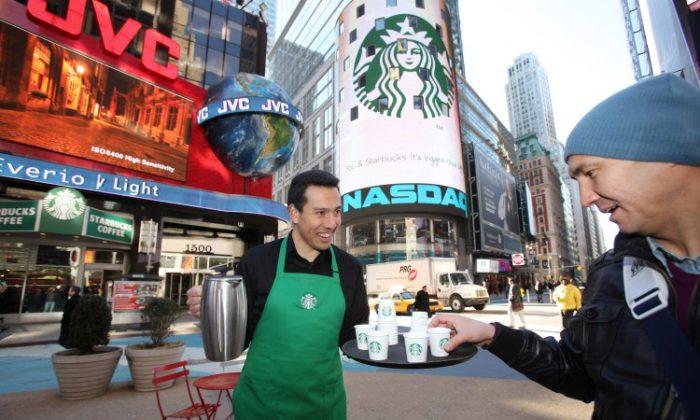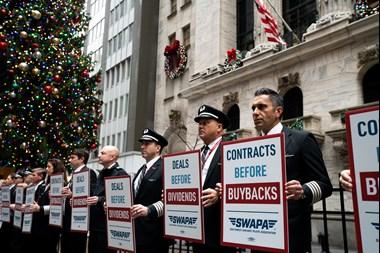Commentary
The Fed’s excess liquidity has goosed up stock prices to record highs. But now, as the Fed looks to normalize rates, executives and corporate boards will need to find other means to maintain, and even enhance, their companies’ stock prices. That can sometimes be done by “re-engineering” the parts of their businesses instead of continuing the status quo.
That’s happening now. In November, for example, we saw plans for Johnson & Johnson (J&J) and General Electric (GE) to break up their operating divisions into two separate companies each, with GE adding a third company dedicated to what it calls “energy transition.”
Splitting up a conglomerate has advantages and disadvantages and can be done by various means. But segregating operating divisions into separate companies can tend to focus executive management and allows analysts to better measure performance relative to other industries.
Mergers and acquisitions, on the other hand, nowadays mostly tend to integrate an existing business with a supplier or distributor—so-called “vertical integration,” like Samsung’s manufacturing parts that are used in its mobile phones—or to consolidate a company with its competitors—so-called “horizontal integration, as was found, for example, in Marriott’s acquisition of Starwood.
So, just for fun, and with no particular investment agenda—and with all the appropriate disclaimers that this is most certainly not “investment advice”—let’s just speculate for a moment on the kind of corporate mergers, acquisitions, and divisions that might make sense for 2022.
Amazon, Your Grande Is Waiting
I tease friends that they pay $5 for Starbucks: $1 for the coffee and $4 for all the syrup, whip cream, and sugar to make it drinkable. I take my coffee black, no sugar, so Starbucks always tasted like burnt coffee to me. But Amazon might just lure me to an AmazonGo with a Starbucks inside. Not for the coffee, but for a “grab n’ go” sandwich, salad, soup, or sushi platter. That business model just launched on East 59th Street in Manhattan just a few weeks ago and, from an investor perspective, it’s a slam dunk. Think of it as an upscale 7-11 with better tech.And imagine the revenue enhancement for Starbucks! Instead of lining the walls with big leather lounge chairs, bags of overpriced coffee, mugs, and other slow-moving coffee-related tchotchkes or dessert display cases, Starbucks could instead line them with refrigerated display cases full of high turnover sandwiches, salads, sushi, sodas, waters, energy drinks, and displays of prepackaged heated or microwavable home-cooked meals.
I’m not sure how the logistics would work, particularly delivering perishable foodstuffs to Starbucks stores that now mostly sell a dry commodity (coffee beans) and boiled water, but one would think it doable, especially in locations where Amazon’s Whole Foods subsidiary—with their own deli operations—are located nearby. Besides, the model was mastered years ago by 7-11.
This model is so appealing, in fact, that I can’t imagine Amazon not buying Starbucks; it makes far too much sense.
Mickey D’s Mickey Deeds
The first CEO (after Ray Kroc), Harry Sonneborn, was quoted as saying, “We are not technically in the food business. We are in the real estate business. The only reason we sell fifteen-cent hamburgers is because they are the greatest producer of revenue, from which our tenants can pay us our rent.”So what if there was a “pure play” for McDonald’s real estate holdings? Might it benefit the burger slinger’s shareholders to bundle up some or all of the real estate it owns and spin it off to shareholders as a Real Estate Investment Trust (REIT)?
The company considered doing just that under former CEO Steve Easterbrook, but rejected the notion because it created unspecified “significant financial and operational risks to our business,” including McDonald’s “ability to invest with its franchisees on restaurant remodeling.”
But that was in 2015. McDonald’s missed a significant opportunity, in my view. Since then, the tax law has changed so that any spin-off into an REIT would be taxable, so that McDonald’s would now have to pay tax on the unrealized appreciated value of the real estate; it would not be a tax-free spin-off, as for most such spin-offs.
But so what?
Recognizing the gain on the spin-off would allow shareholders greater flexibility to control the real estate they—not the executives in the McDonald’s C-Suite—indirectly own. For many of these properties, McDonald’s restaurants are probably not the “highest and best use,” for the property, the optimal value that real estate investors seek. Let shareholders decide.
While a spin-off would strip out the portion of corporate-level receipts McDonald’s earns on restaurant rents from corporate-level income subject to tax, those receipts—as REIT income—would be taxed at ordinary rates to shareholders. It would take a considerable amount of number crunching to measure the dollar-to-dollar after tax benefits to shareholders of an REIT distribution, taxed at ordinary tax rates, versus distributions of McDonald’s qualified dividends, which are taxed at a lower rate. But it’s time to reassess the possibilities, particularly for McDonald’s locations near business centers that may not recover from the pandemic.
Copycats
Other companies might take the time to re-think their organizations in the aftermath of GE and J&J.Danaher Corporation (DHR), for example, is a Washington based conglomerate with three different business segments: “Life Sciences,” which makes materials and equipment used in advanced health and genetics research; “Diagnostics,” which makes “instruments, reagents, consumables, software, and services that hospitals, physicians’ offices, reference laboratories, and other critical care settings use to diagnose disease and make treatment decisions”; and “Environmental & Applied Solutions,” which offers products and services that keep food and water resources safe. All three segments are closely related, more or less.
But within the Environmental & Applied Solutions segment is a subsegment that engages in “product identification,” which includes packaging design, “instruments, software, services and consumables for various color and appearance management,” and “printing, marking, coding and traceability applications for consumer, pharmaceutical and industrial products.”
At a glance, the product identification subsegment seems rather far removed from Danaher’s core business operations, and possibly a “growable” business, were its business expertise applied to products well outside the conglomerate’s core business operations.
It might make sense for DHR to separate the product identification subsegment into a stand-alone business and sell it or spin it off.
Ahead for 2022 and Beyond
The breadth, diversity, and ingenuity of American business operations is without equal anywhere in the world. How the managers choose to mix, match, divide, combine, and recombine their assets and operations in search of new markets and greater efficiencies is limited only by executives’ imagination and the skills of their investment bankers. In 2022, with a changing national fiscal, monetary, and societal landscape, the best managers will be actively looking for those kinds of opportunities.This article is for informational purposes only and presents only the opinions and speculations of the author about future events. Nothing herein is intended to be—and it should not be used as—investment, tax, or legal advice. Before making any investment, individuals should always consult their own advisers. The author has no interest in any of the stocks mentioned in this article.





